pod的常见状态,故障原因和探针检测的使用
Pod概念
Pod代表一个deployment单元:a single instance of an application in Kubernetes。
运行单个容器的Pod:将pod看作是单个容器的包装器,kubernetes不直接管理容器,而是管理pods。
运行多个容器的Pod:pod可以将多个容器封装一个单个应用。pod中的多个容器作为整体调度到集群中同一物理机或虚拟机上。pod中多个容器共享资源和依赖项,彼此通信。
pod将这些容器、网络资源和存储资源作为一个单一的可管理实体包装在一起。每个pod分配唯一的ip地址,pod中容器共享netns,包括ip地址和port端口。多个容器之间使用localhost通信。当pod中容器与其他pod通信,需要使用共享的网络资源。pod可以使用多个volume,pod中所有容器都可以访问这些卷。
Pod是Kubernetes的最重要的概念,每一个pod都有一个特殊的被称为“根容器”的Pause容器。Pause容器对应的镜像属于Kubernetes平台的一部分,除了Pause容器,每个Pod还包含一个或多个紧密相关的用户业务容器。通过pause容器,把其他业务容器加入到Pause容器里面,让所有业务容器在同一名称空间内,可以实现网络共享。
Pod status
Unschedulable:Pod不能被调度,kube-scheduler没有匹配到合适的node节点。
PodScheduled:pod正处于调度中,在kube-scheduler刚开始调度的时候,还没有将pod分配到指定的node,在筛选出合适的节点后就会更新etcd数据,将pod分配到指定的node。
Failed:Pod中有容器启动失败而导致pod工作异常。
Unknown:由于某种原因无法获得pod的当前状态,通常是由于与pod所在的node节点通信错误。
Initialized:所有pod中的初始化容器已经完成了
ContainerCreating 正在创建
Running:Pod内部的容器已经被创建并且启动。
Ready:表示pod中的容器已经可以提供访问服务。
Completed 运行完成
Error: pod启动过程中发生错误
NodeLost:Pod所在节点失联
Waiting:Pod等待启动
Terminating:Pod正在被销毁
CrashLoopBackOff :pod创建失败,但是kubelet正在将它重启
ErrImagePull:镜像拉取出错,超时或下载被强制终止
ImagePullBackOff:Pod所在的node节点下载镜像失败
Pending:正在创建Pod但是Pod中的容器还没有全部被创建完成=处于此状态的Pod应该检查Pod依赖的存储是否有权限挂载等。
InvalidImageName:node节点无法解析镜像名称导致的镜像无法下载
ImageInspectError:无法校验镜像,镜像不完整导致
ErrImageNeverPull:策略禁止拉取镜像,镜像中心权限是私有等
RegistryUnavailable:镜像服务器不可用,网络原因或harbor宕机
CreateContainerConfigError:不能创建kubelet使用的容器配置
CreateContainerError:创建容器失败
RunContainerError:pod运行失败,容器中没有初始化PID为1的守护进程等
ContainersNotInitialized:pod没有初始化完毕
ContainersNotReady:pod没有准备完毕
ContainerCreating:pod正在创建中
PodInitializing:pod正在初始化中
DockerDaemonNotReady:node节点decker服务没有启动
NetworkPluginNotReady:网络插件没有启动
imagePullPolicy,镜像下载策略。
Always,总是从仓库下载镜像,默认值。
Never,只使用本地镜像,不下载。
IfNotPresent,优先使用本地镜像,如果没有才从仓库下载镜像。
restartPolicy (容器重启策略):
Pod一旦配置探针,在检测失败时候,会基于 restartPolicy对Pod进行下一步操作:
Always:当容器异常时,k8s自动重启该容器, ReplicationController/Replicaset/Deployment,默认为Always。
OnFailure:当容器失败时(容器停止运行且退出码不为0),k8s自动重启该容器。
Never:不论容器运行状态如何都不会重启该容器,Job或CronJob。
Init容器
理解 Init 容器
每个Pod中可以包含多个容器,应用运行在这些容器里面,同时Pod也可以有一个或多个先于应用容器启动的Init容器。
Init容器与普通的容器非常像,除了如下两点:
- 它们总是运行到完成。
- 每个都必须在下一个启动之前成功完成。
如果Pod的Init容器失败,kubelet会不断地重启该Init容器直到该容器成功为止。然而,如果Pod对应的restartPolicy值为"Never",并且Pod的Init容器失败,则 Kubernetes会将整个Pod状态设置为失败。
为 Pod设置Init 容器需要在Pod规约中添加initContainers字段,该字段以 Container类型对象数组的形式组织,和应用的containers数组同级相邻。参阅API参考的容器章节了解详情。
Init容器的状态在status.initContainerStatuses字段中以容器状态数组的格式返回(类似status.containerStatuses字段)。
与普通容器的不同之处
Init容器支持应用容器的全部字段和特性,包括资源限制、数据卷和安全设置。然而,Init容器对资源请求和限制的处理稍有不同。
同时Init容器不支持lifecycle、livenessProbe、readinessProbe和startupProbe,因为它们必须在Pod就绪之前运行完成。
如果为一个Pod指定了多个Init容器,这些容器会按顺序逐个运行。每个Init 容器必须运行成功,下一个才能够运行。当所有Init容器运行完成时,Kubernetes 才会为Pod初始化应用容器并像平常一样运行。
init容器的作用
1、可以为业务容器提前准备好业务容器的运行环境,比如将业务容器需要 的配置文件提前生成并放在指定位置、检查数据权限或完整性、软件版本等基础运行环境。
2、可以在运行业务容器之前准备好需要的业务数据,比如从OSS下载、或者从其它位置copy。
3、检查依赖的服务是否能够访问。
init容器的特点:
1、一个pod可以有多个业务容器还能在有多个init容器,但是每个init容器和业务容器的运行环境都是隔离的。
2、init容器会比业务容器先启动。
3、init容器运行成功之后才会继续运行业务容器。
4、如果一个pod有多个init容器,则需要从上到下逐个运行并且全部成功, 最后才会运行业务容器。
5、init容器不支持探针检测(因为初始化完成后就退出再也不运行了)。
使用 Init 容器的情况
例如:
定义了一个具有2个Init容器的简单Pod。第一个等待myservice 启动,第二个等待mydb启动。一旦这两个Init容器都启动完成,Pod将启动spec节中的应用容器。
apiVersion: v1 kind: Pod metadata: name: myapp-pod labels: app: myapp spec: containers: - name: myapp-container image: busybox:1.28 command: ['sh', '-c', 'echo The app is running! && sleep 3600'] initContainers: - name: init-myservice image: busybox:1.28 command: ['sh', '-c', "until nslookup myservice.$(cat /var/run/secrets/kubernetes.io/serviceaccount/namespace).svc.cluster.local; do echo waiting for myservice; sleep 2; done"] - name: init-mydb image: busybox:1.28 command: ['sh', '-c', "until nslookup mydb.$(cat /var/run/secrets/kubernetes.io/serviceaccount/namespace).svc.cluster.local; do echo waiting for mydb; sleep 2; done"]
pause容器
Pause容器,又叫Infra 容器,是pod的基础容器,镜像体积只有几百KB 左右,配置在kubelet中,主要的功能是一个pod中多个容器的网络通信。
Infra容器被创建后会初始化Network Namespace,之后其它容器就可以加入到Infra容器中共享Infra容器的网络了,因此如果一个Pod中的两个容器A和B,那么关系如下 :
1、A容器和B容器能够直接使用localhost通信;
2、A容器和B容器可以可以看到网卡、IP与端口监听信息。
3、Pod只有一个IP地址,也就是该Pod的Network Namespace对应的IP地址(由Infra容器初始化并创建)。
4、k8s环境中的每个Pod有一个独立的IP地址(前提是地址足够用),并且此IP被当前Pod中所有容器在内部共享使用。
5、pod删除后Infra容器随机被删除,其IP被回收。
Pause容器共享的Namespace:
1、NET Namespace:Pod中的多个容器共享同一个网络命名空间,即使用相同的IP和端口信息。
2、IPC Namespace:Pod中的多个容器可以使用System V IPC或POSIX消息队列进行通信。
3、UTS Namespace:pod中的多个容器共享一个主机名。MNT Namespace、PID Namespace、User Namespace未共享。
探针检测
探针是由kubelet对容器执行的定期诊断,以保证Pod的状态始终处于运行状态,要执行诊断,kubelet调用由容器实现的Handler(处理程序),也成为Hook(钩子),
有三种类型的处理程序
ExecAction:
在容器内执行指定命令,如果命令退出时返回码为0则认为诊断成功。
TCPSocketAction:
对指定端口上的容器的IP地址进行TCP检查,如果端口打开,则诊断被认为是成功的。
HTTPGetAction:
对指定的端口和路径上的容器的IP地址执行HTTPGet请求,如果响应的状态码大于等于200且小于400,则诊断被认为是成功的。
每次探测都将获得以下三种结果之一:
成功:容器通过了诊断。
失败:容器未通过诊断。
未知:诊断失败,因此不会采取任何行动。
探针类型
1、startupProbe:启动探针,kubernetes v1.16引入
判断容器内的应用程序是否已启动完成,如果配置了启动探测,则会先禁用所有其它的探测,直到startupProbe检测成功为止,如果startupProbe探测失败,则kubelet将杀死容器,容器将按照重启策略进行下一步操作,如果容器没有提供启动探测,则默认状态为成功
2、livenessProbe:存活探针
检测容器容器是否正在运行,如果存活探测失败,则kubelet会杀死容器,并且容器将受到其重启策略的影响,如果容器不提供存活探针,则默认状态为 Success,livenessProbe用于控制是否重启pod。
3、readinessProbe:就绪探针
如果就绪探测失败,端点控制器将从与Pod匹配的所有Service的端点中删除该Pod的IP地址,初始延迟之前的就绪状态默认为Failure(失败),如果容器不提供就绪探针,则默认状态为Success,readinessProbe用于控制pod是否添加至service。
探针通用配置参数
探针有很多配置字段,可以使用这些字段精确的控制存活和就绪检测的行为:
官网文档:
initialDelaySeconds: 120
初始化延迟时间,告诉kubelet在执行第一次探测前应该等待多少秒,默认是0秒,最小值是0
periodSeconds: 60
探测周期间隔时间,指定了kubelet应该每多少秒秒执行一次存活探测,默认是10秒。最小值是1
timeoutSeconds: 5
单次探测超时时间,探测的超时后等待多少秒,默认值是1秒,最小值是1。
successThreshold: 1
从失败转为成功的重试次数,探测器在失败后,被视为成功的最小连续成功数,默认值是1,存活探测的这个值必须是1,最小值是 1。
failureThreshold: 3
从成功转为失败的重试次数,当Pod启动了并且探测到失败,Kubernetes的重试次数,存活探测情况下的放弃就意味着重新启动容器,就绪探测情况下的放弃Pod 会被打上未就绪的标签,默认值是3,最小值是1。
Pod检测时间为:
initialDelaySeconds+ failureThreshold*periodSeconds=Total
探针http配置参数:
HTTP探测器可以在httpGet上配置额外的字段:
host:
连接使用的主机名,默认是Pod的IP,也可以在HTTP头中设置 “Host” 来代替。
scheme: HTTP
用于设置连接主机的方式(HTTP还是HTTPS),默认是HTTP。
path: /monitor/index.html
访问HTTP服务的路径。
httpHeaders:
请求中自定义的HTTP头,HTTP头字段允许重复。
port: 80
访问容器的端口号或者端口名,如果数字必须在1~65535之间。
示例:
1、使用livenessprobe中的httpGet探针检测pod
检测时间为
initialDelaySeconds+ failureThreshold * periodSeconds=Total
5 3 10 35s
root@deploy:/health-check# vim http-livenessprobe.yaml apiVersion: apps/v1 kind: Deployment metadata: name: web-deployment namespace: test spec: replicas: 2 selector: matchLabels: app: web template: metadata: labels: app: web spec: containers: - image: nginx name: nginx imagePullPolicy: IfNotPresent ports: - containerPort: 80 livenessProbe: httpGet: path: /index.html port: 80 scheme: HTTP initialDelaySeconds: 5 periodSeconds: 10 timeoutSeconds: 5 successThreshold: 1 failureThreshold: 3 --- apiVersion: v1 kind: Service metadata: name: web-svc namespace: test spec: ports: - name: http port: 80 targetPort: 80 protocol: TCP type: NodePort selector: app: web
查看pod
root@deploy:/health-check# kubectl get pods NAME READY STATUS RESTARTS AGE web-deployment-6cb7795f8c-bqmdh 1/1 Running 0 9m39s web-deployment-6cb7795f8c-w8qlb 1/1 Running 0 9m39s
将livenessprobe中的path URL路径修改成错误的
livenessProbe: httpGet: path: /test/index.html port: 80 scheme: HTTP initialDelaySeconds: 5 periodSeconds: 10 timeoutSeconds: 5 successThreshold: 1 failureThreshold: 3
30秒后进行第一次重启容器

第三次重启容器则判定诊断失败,pod状态为CrashLoopBackOff重载重启状态

查看pod详细运行信息
root@deploy:/health-check# kubectl describe pods web-deployment-5d747cdcd-gw8gm

2、使用readinessprobe中的httpGet探针检测pod
root@deploy:/health-check# cat http-readinessprobe.yaml apiVersion: apps/v1 kind: Deployment metadata: name: web-deployment namespace: test spec: replicas: 2 selector: matchLabels: app: web template: metadata: labels: app: web spec: containers: - image: nginx name: nginx imagePullPolicy: IfNotPresent ports: - containerPort: 80 readinessProbe: httpGet: path: /index.html port: 80 scheme: HTTP initialDelaySeconds: 5 periodSeconds: 3 timeoutSeconds: 5 successThreshold: 1 failureThreshold: 3 --- apiVersion: v1 kind: Service metadata: name: web-svc namespace: test spec: ports: - name: http port: 80 targetPort: 80 protocol: TCP type: NodePort selector: app: web
模拟故障,修改httpGet path的URL地址
readinessProbe: httpGet: path: /tmp/index.html port: 80 scheme: HTTP initialDelaySeconds: 5 periodSeconds: 3 timeoutSeconds: 5 successThreshold: 1 failureThreshold: 3
等待两轮检测后,由于readiness探针检测判断容器检测失败,则控制service 的endpoints地址取消添加pod 的ip
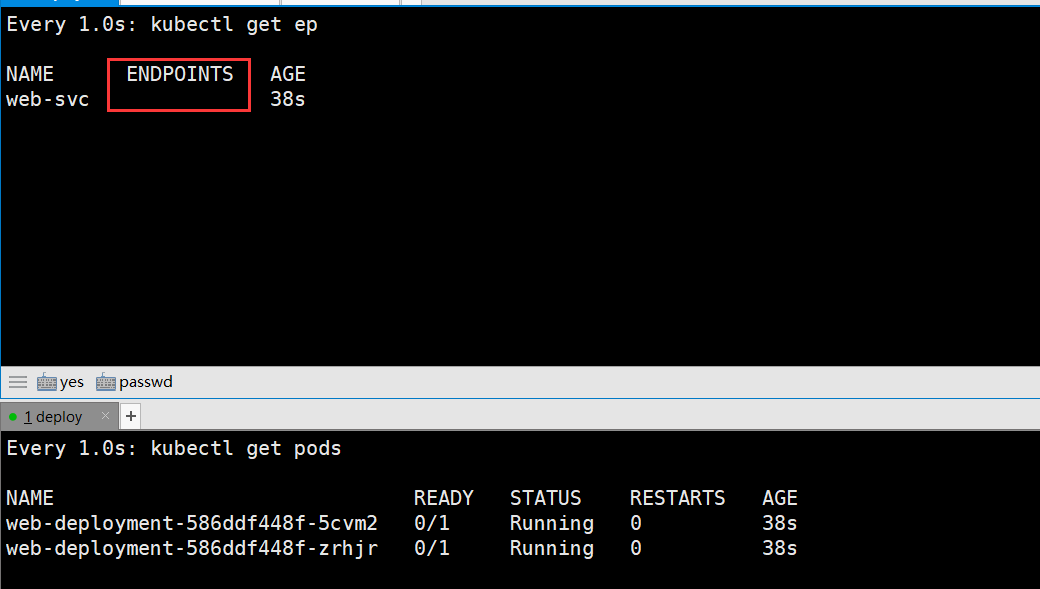
使用startupprobe探针httpGet检测
启动时对pod进行httpGet path URL请求路径检测
root@deploy:/health-check# cat http-startupprobe.yaml apiVersion: apps/v1 kind: Deployment metadata: name: web-deployment namespace: test spec: replicas: 2 selector: matchLabels: app: web template: metadata: labels: app: web spec: containers: - image: nginx name: nginx imagePullPolicy: IfNotPresent ports: - containerPort: 80 startupProbe: httpGet: path: /tmp/index.html port: 80 scheme: HTTP initialDelaySeconds: 5 periodSeconds: 3 timeoutSeconds: 5 successThreshold: 1 failureThreshold: 3 --- apiVersion: v1 kind: Service metadata: name: web-svc namespace: test spec: ports: - name: http port: 80 targetPort: 80 protocol: TCP type: NodePort selector: app: web
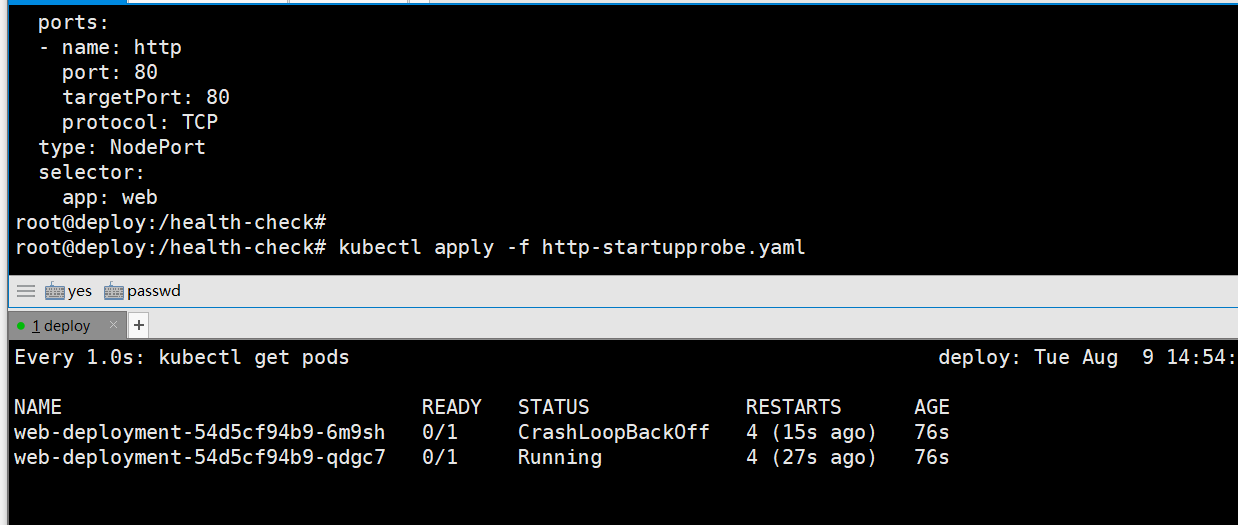
3、使用livenessprobe中的tcpSocket探针检测pod
root@deploy:/health-check# cat tcp-livenessprobe.yaml apiVersion: apps/v1 kind: Deployment metadata: name: web-deployment namespace: test spec: replicas: 2 selector: matchLabels: app: web template: metadata: labels: app: web spec: containers: - image: nginx name: nginx imagePullPolicy: IfNotPresent ports: - containerPort: 80 livenessProbe: tcpSocket: port: 80 initialDelaySeconds: 5 periodSeconds: 3 timeoutSeconds: 5 successThreshold: 1 failureThreshold: 3 --- apiVersion: v1 kind: Service metadata: name: web-svc namespace: test spec: ports: - name: http port: 80 targetPort: 80 protocol: TCP type: NodePort selector: app: web
模拟故障,修改tcpSocket检测端口原80为81
livenessProbe: tcpSocket: port: 81 initialDelaySeconds: 5 periodSeconds: 3 timeoutSeconds: 5 successThreshold: 1 failureThreshold: 3
livenessprobe检测容器失败,第一次重启pod
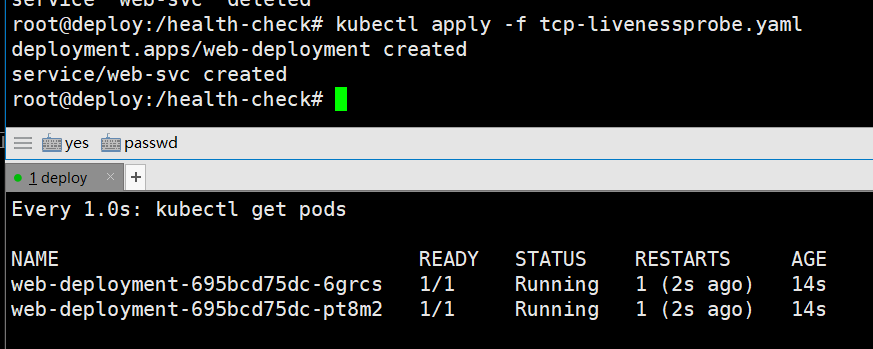
三次检测后,将pod状态置为CrashLoopBackOff
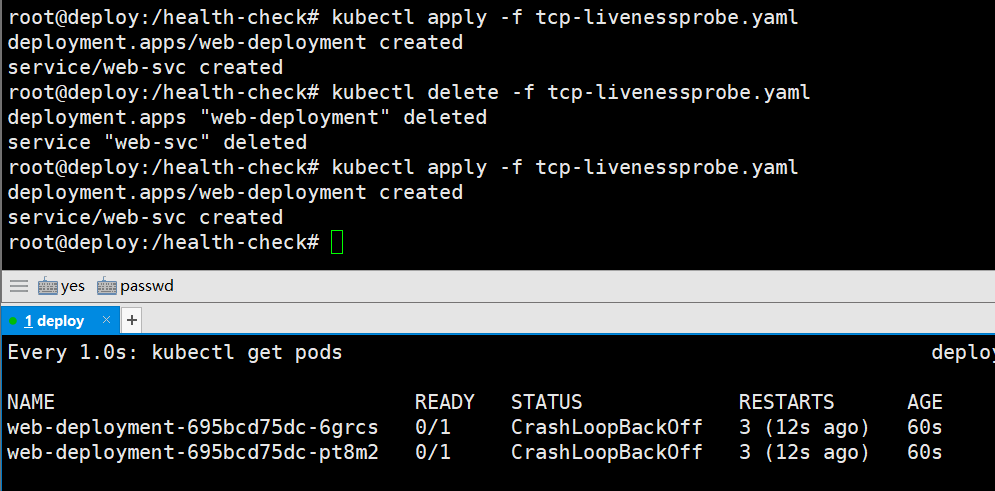
4、readinessprobe使用tcpSocket探针检测pod
root@deploy:/health-check# cat tcp-readinessprobe.yaml apiVersion: apps/v1 kind: Deployment metadata: name: web-deployment namespace: test spec: replicas: 2 selector: matchLabels: app: web template: metadata: labels: app: web spec: containers: - image: nginx name: nginx imagePullPolicy: IfNotPresent ports: - containerPort: 80 readinessProbe: tcpSocket: port: 81 initialDelaySeconds: 5 periodSeconds: 3 timeoutSeconds: 5 successThreshold: 1 failureThreshold: 3 --- apiVersion: v1 kind: Service metadata: name: web-svc namespace: test spec: ports: - name: http port: 80 targetPort: 80 protocol: TCP type: NodePort selector: app: web
探针检测失败,service无法得到endpoint的pod ip
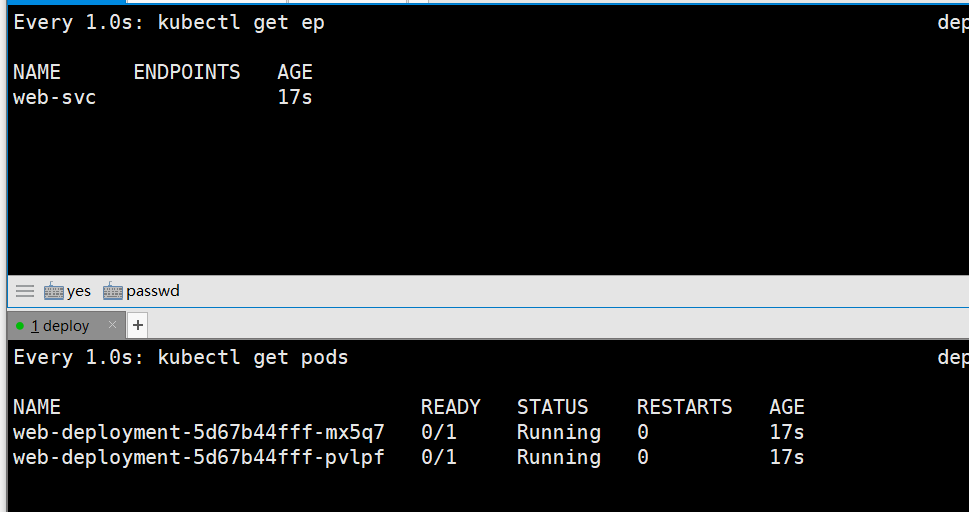
5、cmd探针检测使用
模拟使用cmd命令探针检测pod运行状态
root@deploy:/health-check# cat cmd-livenessprobe.yaml apiVersion: apps/v1 kind: Deployment metadata: name: web-deployment namespace: test spec: replicas: 1 selector: matchLabels: app: web template: metadata: labels: app: web spec: containers: - image: nginx name: nginx imagePullPolicy: IfNotPresent ports: - containerPort: 80 livenessProbe: exec: command: ["curl","http://localhost:8080"] initialDelaySeconds: 10 periodSeconds: 2 timeoutSeconds: 5 successThreshold: 1 failureThreshold: 3 --- apiVersion: v1 kind: Service metadata: name: web-svc namespace: test spec: ports: - name: http port: 80 targetPort: 80 protocol: TCP type: NodePort selector: app: web
运行后则检测pod失败,重启pod
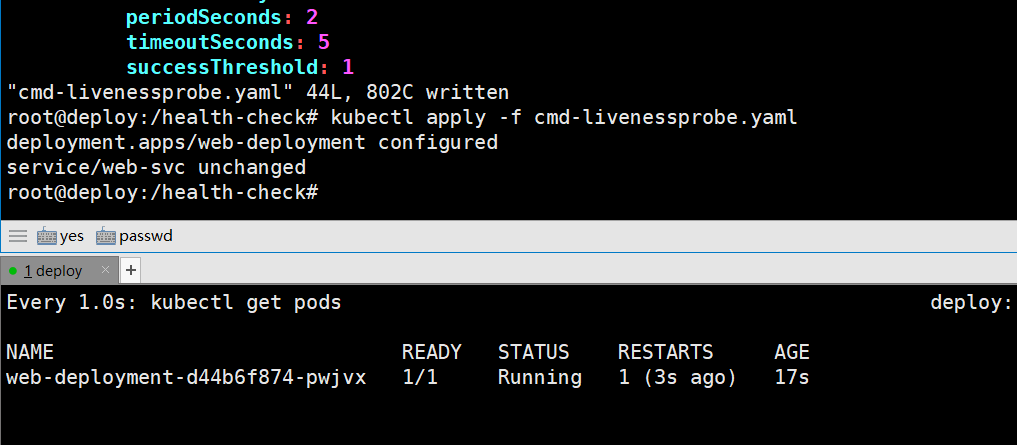
6、三种探针检测结合使用
创建startupProbe、livenessProbe和readinessProbe探针检测
root@deploy:/health-check# cat all.yaml apiVersion: apps/v1 kind: Deployment metadata: name: web-deployment namespace: test spec: replicas: 1 selector: matchLabels: app: web template: metadata: labels: app: web spec: containers: - image: nginx name: nginx imagePullPolicy: IfNotPresent ports: - containerPort: 80 startupProbe: httpGet: path: /index.html port: 80 scheme: HTTP initialDelaySeconds: 5 periodSeconds: 3 failureThreshold: 3 livenessProbe: httpGet: path: /index.html port: 80 scheme: HTTP initialDelaySeconds: 5 periodSeconds: 3 timeoutSeconds: 5 successThreshold: 1 failureThreshold: 3 readinessProbe: httpGet: path: /index.html port: 80 scheme: HTTP initialDelaySeconds: 5 periodSeconds: 3 timeoutSeconds: 5 successThreshold: 1 failureThreshold: 3 --- apiVersion: v1 kind: Service metadata: name: web-svc namespace: test spec: ports: - name: http port: 80 targetPort: 80 protocol: TCP type: NodePort selector: app: web

模拟startupProbe探针故障,修改成错误的URL地址
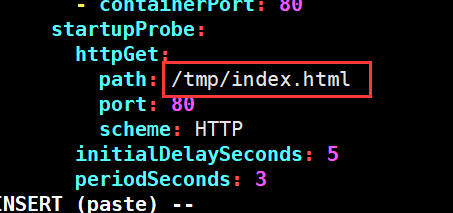
启动失败,startupProbe探针检测失败
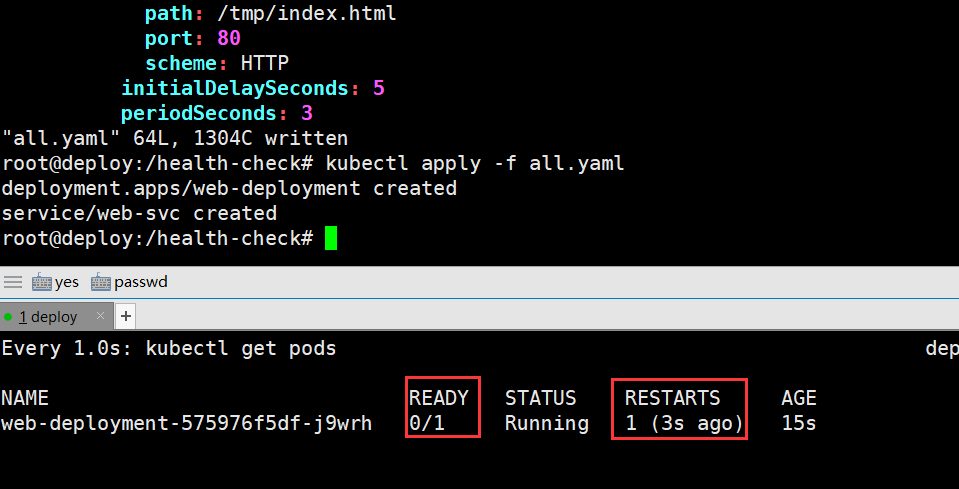
模拟livenessProbe探针故障,修改成错误的URL地址
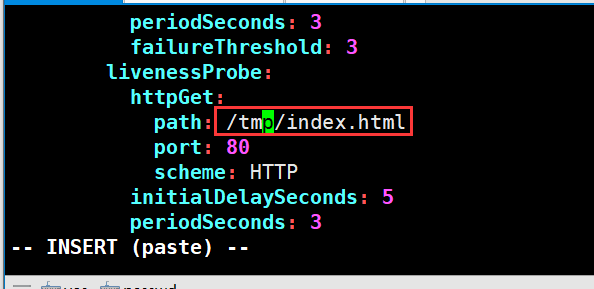
第一次启动成功,startupProbe探针检测失败,重启pod
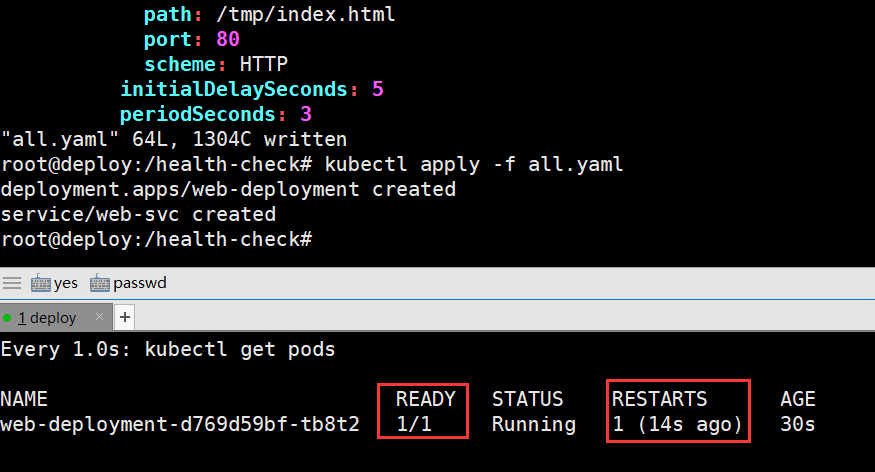
模拟readinessProbe探针故障,修改成错误的URL地址
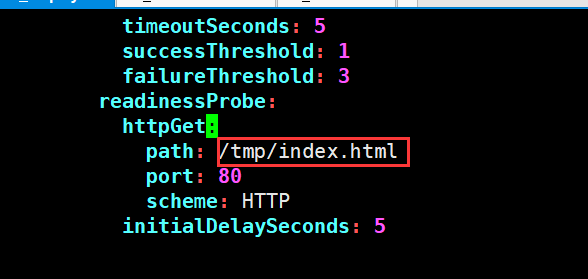
readinessProbe探针检测失败,将svc endpoint地址置空

postStart 和 preStop
postStart和preStop handlers处理函数
postStart:
Pod被创建后立即执行检测,即不等待pod中的服务启动。
如果postStart执行失败pod不会继续创建
preStop:
在pod被停止前执行
示例:
启动pod前和删除pod前,修改index.html文件
root@deploy:/health-check# cat deployment.yaml apiVersion: apps/v1 kind: Deployment metadata: name: web-deployment namespace: test spec: replicas: 1 selector: matchLabels: app: web template: metadata: labels: app: web spec: containers: - image: nginx name: nginx imagePullPolicy: IfNotPresent lifecycle: postStart: exec: command: ["bin/sh","-c","echo 'hello' > /usr/share/nginx/html/index.html"] preStop: exec: command: ["bin/sh","-c","echo 'goodbye' /usr/share/nginx/html/index.html"] --- apiVersion: v1 kind: Service metadata: name: web-svc namespace: test spec: ports: - name: http port: 80 targetPort: 80 protocol: TCP type: NodePort selector: app: web
查看svc nodeport
root@deploy:/health-check# kubectl get svc NAME TYPE CLUSTER-IP EXTERNAL-IP PORT(S) AGE web-svc NodePort 10.100.200.2 <none> 80:46874/TCP 2m38s
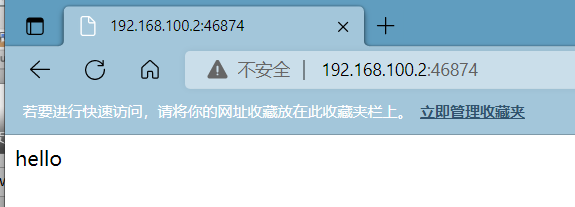
Pod的终止流程
删除pod Pod被设置为”Terminating”状态、从service的Endpoints列表中删除并不再接受客户端请求。
执行PreStop Kubernetes向pod中的容器发送SIGTERM信号(正常终止信号)终止pod里面的主进程,这个信号让容器知道自己很快将会被关闭。
terminationGracePeriodSeconds: 60
可选终止等待期,如果有设置删除宽限时间,则等待宽限时间到期,否则最多等待30s。
查看详细帮助描述terminationGracePeriodSeconds
root@deploy:/health-check# kubectl explain Deployment.spec.template.spec.terminationGracePeriodSeconds KIND: Deployment VERSION: apps/v1 terminationGracePeriodSeconds <integer> root@deploy:/health-check# cat deployment.yaml apiVersion: apps/v1 kind: Deployment metadata: name: web-deployment namespace: test spec: replicas: 1 selector: matchLabels: app: web template: metadata: labels: app: web spec: terminationGracePeriodSeconds: 60 containers: - image: nginx name: nginx imagePullPolicy: IfNotPresent lifecycle: postStart: exec: command: ["bin/sh","-c","echo 'hello' > /usr/share/nginx/html/index.html"] preStop: exec: command: ["bin/sh","-c","echo 'goodbye' /usr/share/nginx/html/index.html"]
Kubernetes等待指定的时间称为优雅终止宽限期,默认情况下是30秒,值得注意的是等待期与preStop Hook和SIGTERM信号并行执行,即Kubernetes可能不会等待preStop Hook完成(最长30秒之后主进程还没有结束就就强制终止pod)。 SIGKILL信号被发送到Pod,并删除Pod。

本文来自博客园,作者:PunchLinux,转载请注明原文链接:https://www.cnblogs.com/punchlinux/p/16566690.html



【推荐】国内首个AI IDE,深度理解中文开发场景,立即下载体验Trae
【推荐】编程新体验,更懂你的AI,立即体验豆包MarsCode编程助手
【推荐】抖音旗下AI助手豆包,你的智能百科全书,全免费不限次数
【推荐】轻量又高性能的 SSH 工具 IShell:AI 加持,快人一步
· 无需6万激活码!GitHub神秘组织3小时极速复刻Manus,手把手教你使用OpenManus搭建本
· C#/.NET/.NET Core优秀项目和框架2025年2月简报
· Manus爆火,是硬核还是营销?
· 终于写完轮子一部分:tcp代理 了,记录一下
· 【杭电多校比赛记录】2025“钉耙编程”中国大学生算法设计春季联赛(1)